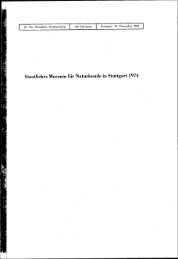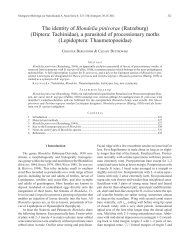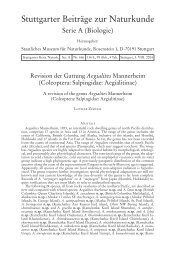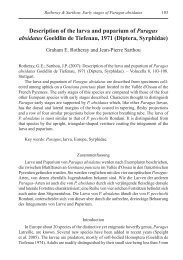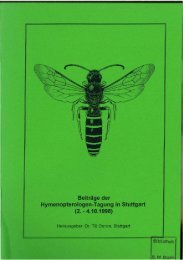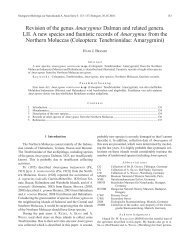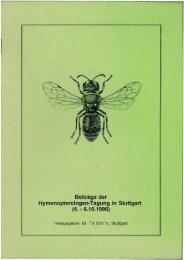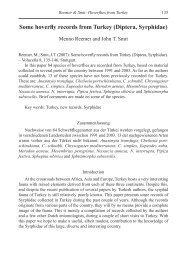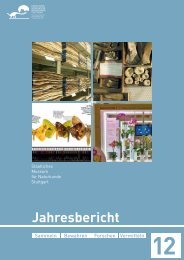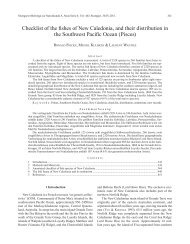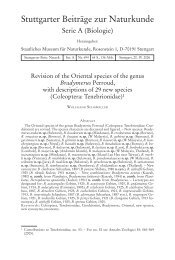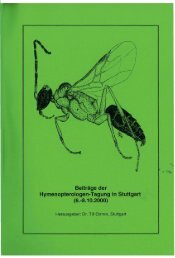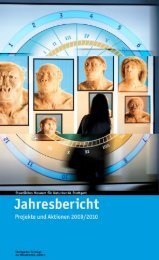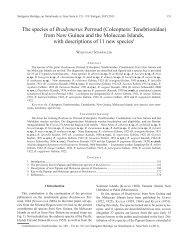Coleoptera: Tenebrionidae: Cnodalonini - Staatliches Museum für ...
Coleoptera: Tenebrionidae: Cnodalonini - Staatliches Museum für ...
Coleoptera: Tenebrionidae: Cnodalonini - Staatliches Museum für ...
Create successful ePaper yourself
Turn your PDF publications into a flip-book with our unique Google optimized e-Paper software.
Stuttgarter Beiträge zur Naturkunde A, Neue Serie 4: 289–296; Stuttgart, 30.IV.2011. 289The genus Derosphaerus Thomson (<strong>Coleoptera</strong>: <strong>Tenebrionidae</strong>:<strong>Cnodalonini</strong>) in Borneo, with description of a new species 1WOLFGANG SCHAWALLERAbstractDistributional data, photos of the beetles and drawings of the aedeagi (except D. coerulescens) are given forall nine species of the tenebrionid genus Derosphaerus Thomson, 1858 (subfamily Stenochiinae Kirby, 1837, tribe<strong>Cnodalonini</strong> Gistel, 1856) from Borneo. A new species (D. emasicus n. sp.) is described, which is unique in the genusbecause of the humped elytra and the mucronate female elytral apex. D. metallescens Fairmaire, 1893 is considereda new junior synonym of D. viriditinctus (Fairmaire, 1882). Derosphaerus ericmatthewsi n. nom. for D. matthewsiSchawaller, 2005 (not D. matthewsi Kaszab, 1987) is proposed. A key to the species is added.K e y w o r d s : <strong>Coleoptera</strong>, <strong>Tenebrionidae</strong>, Derosphaerus, Borneo, taxonomy, new species, elytral mucro, distribution.ZusammenfassungAlle neun Arten der Tenebrioniden-Gattung Derosphaerus Thomson, 1858 (Unterfamilie Stenochiinae Kirby,1837, Tribus <strong>Cnodalonini</strong> Gistel, 1856) aus Borneo werden anhand von Funddaten, Fotografien der Käfer und Zeichnungender Aedaeagi (außer D. coerulescens) zusammenfassend dargestellt. Eine neue Art (D. emasicus n. sp.)wird beschrieben, deren gebuckelte Elytren und Mukro-ähnliche Elytrenspitze der Weibchen einmalig sind innerhalbder Gattung. D. metallescens Fairmaire, 1893 wird als neues jüngeres Synonym von D. viriditinctus (Fairmaire,1882) angesehen. Derosphaerus ericmatthewsi n. nom. für D. matthewsi Schawaller, 2005 (nicht D. matthewsiKaszab, 1987) wird vorgeschlagen. Ein Bestimmungsschlüssel der behandelten Arten ist angefügt.Contents1 Introduction .........................................................................................................................................................2892 The species ..........................................................................................................................................................2903 Key to the Bornean species of Derosphaerus ....................................................................................................2954 References ...........................................................................................................................................................2961 IntroductionThe tenebrionid genus Derosphaerus Thomson, 1858(subfamily Stenochiinae Kirby, 1837, tribe <strong>Cnodalonini</strong>Gistel, 1856) contains about 100 species occurring inthe southeastern Palaearctic (in a wider sense includingChina) and the Oriental, Australian-Papuan and Africa-Madagascar regions. KASZAB (1987) revised the Australian-Papuanspecies giving also a preliminary diagnosis ofthe genus, and SCHAWALLER (2007) summarized the fewHimalayan species. The numerous congeners of the otherregions have never been revised, therefore species identificationsare problematic and the distributional range ofmost species is widely unknown. Moreover, newly collectedspecies with peculiar characters might modify the genericlimits (SCHAWALLER 2005). The aedeagi of the congenersdiffer not only in shape (compare Figs. 10–17), butalso strongly vary in the relation of the aedeagal length/body length (between 13.5 % and 38 %, see Tab. 1).Tab. 1. Derosphaerus spp. from Borneo, aedeagus length, bodylength, and relation aedeagus length/body length of selectedspecimens.SpeciesAedeaguslength(mm)Bodylength(mm)Aedeagus length/body length( percent)D. aeruginosus 2.4 13.0 18.5D. coerulescens – 15.0 –D. emasicus n. sp. 3.4 12.5 27.2D. ericmatthewsi 3.5 12.0 29.2D. fuscatus 2.3 17.0 13.5D. hauschildi 1.8 11.0 16.4D. morio 3.6 18.0 20.0D. vicinus 4.5 11.8 38.0D. viriditinctus 1.9 12.5 15.4GEBIEN (1914) presented a preliminary list and an identificationkey to the Bornean species of Derosphaerus un-1Contributions to <strong>Tenebrionidae</strong>, no. 89. – For no. 88 see: Stuttgarter Beiträge zur Naturkunde A, Neue Serie 4 (2011).
290 STUTTGARTER BEITRÄGE ZUR NATURKUNDE A Neue Serie 4der the name Encyalesthus Motschulsky, 1860, which is ajunior synonym of Derosphaerus (KASZAB 1987). In thecontext of the description of a new species with an “unusual”elytral mucro in the females (Fig. 1), I take thechance and present newly collected material of all speciesfrom Borneo. Photographs of all Bornean species are addedto facilitate subsequent identifications. Altogether, ninespecies of Derosphaerus are currently known from Borneo.An additional species with doubtful origin remainsunnamed. A few records from Sumatra, Seram, Java, andthe Philippines are also included.BMNHCCZGCRGTHNHMMHNGNHMBSMNSZSMAcronyms of depositoriesThe Natural History <strong>Museum</strong>, LondonCollection Dr. CARSTEN ZORN, GnoienCollection Dr. ROLAND GRIMM, TübingenHungarian Natural History <strong>Museum</strong>, BudapestMuséum d’Histoire Naturelle, GenèveNaturhistorisches <strong>Museum</strong>, Basel<strong>Staatliches</strong> <strong>Museum</strong> für Naturkunde, StuttgartZoologische Staatssammlung, MünchenAcknowledgementsFor the loan of material and hospitality during my visitsfor comparative studies I thank Dr. MICHAEL BALKE (Munich),MAX BARCLAY (London), Dr. MICHEL BRANCUCCI (Basel), Dr.ROLAND GRIMM (Tübingen), Dr. IVAN LÖBL (Geneva), Dr. OTTÓMERKL (Budapest), Dr. EVA SPRECHER (Basel) and Dr. CARSTENZORN (Gnoien). JOHANNES REIBNITZ (Stuttgart) prepared the photographsby using a Leica DFC 480 digital camera on a LeicaMZ16 APO microscope, and subsequently processed the digitalphotographs using Leica LAS software. Thanks are due to thereferees, Dr. ROLAND GRIMM and DR. OTTÓ MERKL, for their helpfulcomments.2 The speciesDerosphaerus aeruginosus (Fabricius, 1787)(Figs. 2, 12)Helops aeruginosus Fabricius, 1787.Encyalesthus aeneus Pic, 1929 syn.S t u d i e d m a t e r i a l : Sumatra, Dolok Merangir, 1972–1991, leg. D. ERBER & W. DIEHL, 6 ex. SMNS. – Sumatra, PadangPanjang, 700–1000 m, 21.–25.I.1995, leg. C. ZORN, 2 ex.CCZG. – Borneo, without further data, 1 ex. SMNS. – Borneo,Sarawak, Pamai near Kuching, 5.VIII.1993, without collector,1 ex. CRGT. – Borneo, Sabah, Mt. Kinabalu, 28.V.1999, leg.Z. SMRŘ, 1 ex. SMNS. – Borneo, Sabah, Tambunan, 16.–19.I.2010, leg. R. GRIMM, 4 ex. CRGT. – Borneo, Sabah, Tenom,300 m, 24.–25.I.2010, leg. R. GRIMM, 3 ex. CRGT. – Borneo,Sabah, S Tenom, Kuala Tomani, 25.I.2010, leg. R. GRIMM,2 ex. CRGT. – Borneo, Sabah, Kudat, Bak Bak, 25.III.2007, leg.R. GRIMM, 4 ex. CRGT. – Borneo, Sabah, Danum Valley, 75 kmSW Lahad Datu, 200–600 m, leg. M. HIERMEIER, 1 ex. CRGT. –Borneo, Kalimantan, Apokayan, Long Ampung, 700 m, 10.–25.II.1997, leg. C. & P. ZORN, 1 ex. SMNS.D i s t r i b u t i o n : Southeastern Asia (Nepal, NE India,Laos, W Malaysia), Borneo (type locality), Sumatra, Java.Derosphaerus coerulescens (Guérin-Méneville, 1830)(Fig. 4)Helops coerulescens Guérin-Méneville, 1830.Encyalesthus transversicollis Fairmaire, 1893 syn.Encyalesthus coelestinus Fairmaire, 1896 syn.Encyalesthus ceramensis Gebien, 1920 syn.Encyalesthus robustus Pic, 1923 syn.S t u d i e d m a t e r i a l : Ceram [= Seram], without furtherdata, 1 ♀ SMNS.Remarks: Encyalesthus transversicollis Fairmaire,1893, described from Borneo, was synonymized byA RDOIN (1969) based on the examination of the types. Newmaterial from Borneo, which is identical with the abovelisted female from Seram, is unknown to me. However,because of zoogeographical reasons, it might be possiblethat D. transversicollis (Fairmaire, 1893) is a valid speciesand not a synonym of D. coerulescens (Guérin-Méneville,1830). Unfortunately, the type of D. transversicollis wasnot available for comparison.D i s t r i b u t i o n : Buru (type locality), Seram, Borneo(?).Derosphaerus emasicus n. sp.(Figs. 1, 16)Holotype (♂): Borneo, Sabah, Crocker Range NP, GunungEmas, 1600 m, 6.–18.VI.1996, leg. J. KODADA & F. CIAMPOR,SMNS.P a r a t y p e s : Borneo, Sabah, Sapulut, 23.VI.1998, leg.J. KODADA & F. CIAMPOR, 1 ♂ SMNS. – Borneo, Sabah, KinabaluNP, Headquarters, 1300–1600 m, 23.VIII.1998, leg. D. BARTSCH& C. HÄUSER, 1 ♂ SMNS. – Borneo, Sabah, Kinabalu NP,Headquarters, 1560 m, 3.–13.VIII.1988, leg. A. SMETANA, 1 ex.MHNG. – Borneo, Sabah, Crocker Range NP, Gunung Emas,15.–27.IV.1993, leg. I. JENIŠ & M. STRBA, 1 ex. ZSM. – Borneo,Sabah, Crocker Range NP, Gunung Emas, 500–1900 m, 6.–21.V.1995, leg. I. JENIŠ, 6 ex. ZSM, 2 ♀♀ SMNS, 2 ex. BMNH,1 ex. HNHM. – Borneo, Sabah, Crocker Range, road KotaKinabalu to Tambunan, Gunung Emas, 1650 m, 22.III.–6.IV.2000, leg. L. BOLM, 1 ex. NHMB. – Borneo, Sabah, Kinabalu NP,Headquarters, 1600 m, 8.–10.VII.1992, leg. E. HEISS, 1 ex. CRGT.– Borneo, Sabah, Kinabalu NP, Headquarters, 1550 m, 22.–25.V.2005, leg. R. GRIMM, 2 ex. CRGT. – Borneo, Sabah, KinabaluNP, Headquarters, 1550 m, 28.XI.2006, leg. R. GRIMM, 2 ex.CRGT. – Borneo, Sabah, Kinabalu NP, Headquarters, 1550 m,27.III.2007, leg. R. GRIMM, 5 ex. CRGT. – Borneo, Sabah, KinabaluNP, Headquarters, 1550 m, 7.–9.I.2010, leg. R. GRIMM, 1 ex.CRGT.E t y m o l o g y : The new species is named after Gunung(= Mount) Emas in the Crocker Range, where the holotype hasbeen collected.D e s c r i p t i o n : Body length 12.0–13.0 mm. Bodyelongate, subparallel-sided; surface, including legs andantennae, uniformly shining olive-bronze metallic, withoutsetation. Head with fine and equal punctation; genaenot widened, fronto-clypeal suture deep; eyes not divided,distance between eyes on frons in both sexes as wideas length of eyes, frons without impressions or other
SCHAWALLER, DEROSPHAERUS IN BORNEO 291Figs. 1–4. Derosphaerus spp. from Borneo, dorsal views. – 1. D. emasicus n. sp., ♂ holotype and ♀ elytral mucro. 2. D. aeruginosus.3. D. sp. 4. D. coerulescens. – Scale: 10 mm.
292 STUTTGARTER BEITRÄGE ZUR NATURKUNDE A Neue Serie 4Figs. 5–9. Derosphaerus spp. from Borneo, dorsal views. – 5. D. viriditinctus. 6. D. vicinus. 7. D. hauschildi. ♂ lectotype. 8. D. fuscatus.9. D. morio. – Scale: 10 mm.
SCHAWALLER, DEROSPHAERUS IN BORNEO 293Figs. 10–17. Derosphaerus spp. from Borneo, aedeagi, dorsal (left) and lateral (right) views. – 10. D. viriditinctus. 11. D. fuscatus.12. D. aeruginosus. 13. D. sp. 14. D. hauschildi. 15. D. vicinus. 16. D. emasicus n. sp. 17. D. morio. – Scale: 2 mm.
296 STUTTGARTER BEITRÄGE ZUR NATURKUNDE A Neue Serie 48 Male posterior tibiae dilated in the mediobasal part; aedeaguswith plate-like apicale (Figs. 5, 10). ........D. viriditinctus– Male posterior tibiae without modification; aedeagus withregular triangular apicale (Figs. 7, 14). ........... D. hauschildi4 ReferencesARDOIN, P. (1969): Note synonymique (Col. <strong>Tenebrionidae</strong>). –Bulletin de la Société entomologique de France 74: 124–127.GEBIEN, H. (1914): Die Tenebrionidenfauna Borneos. Erster Teil.– Sarawak <strong>Museum</strong> Journal (2) 5: 1–58.KASZAB, Z. (1987): Die papuanisch-australischen Arten der GattungDerosphaerus Thomson, 1858 (<strong>Coleoptera</strong>: <strong>Tenebrionidae</strong>).– Acta zoologica Academiae scientiarum hungaricae33: 41–85.SCHAWALLER, W. (2005): Three new tenebrionids (<strong>Coleoptera</strong>:<strong>Tenebrionidae</strong>) from Sumatra – New species or new genera?– Annales zoologici 55: 565–569.SCHAWALLER, W. (2007): The genus Derosphaerus Thomson inthe Nepal Himalayas (<strong>Coleoptera</strong>: <strong>Tenebrionidae</strong>). – Entomologicabasiliensia 29: 171–175.Author’s address:Dr. WOLFGANG SCHAWALLER, <strong>Staatliches</strong> <strong>Museum</strong> für Naturkunde, Rosenstein 1, 70191 Stuttgart, Germany;e-mail: wolfgang.schawaller@smns-bw.deManuscript received: 7.VI.2010, accepted: 2.VII.2010.



